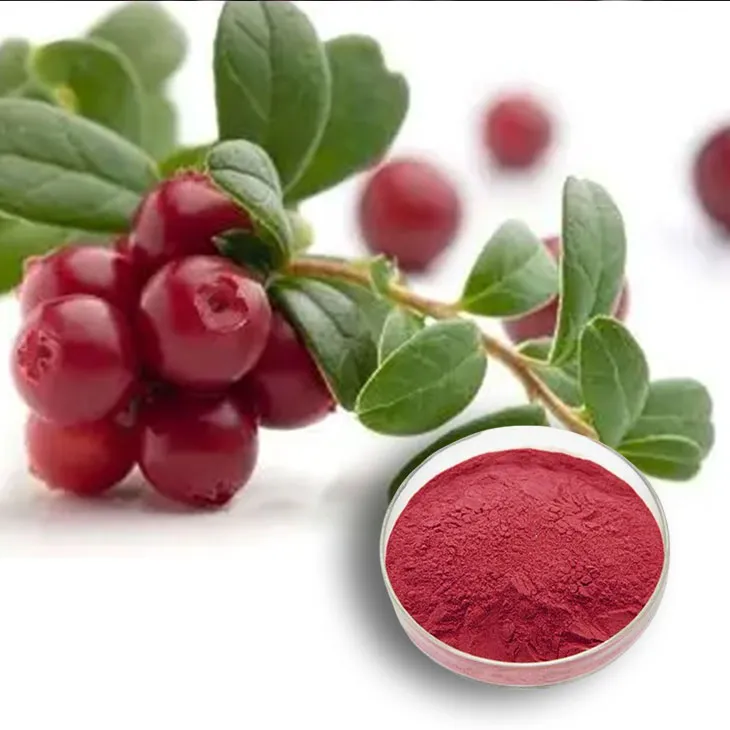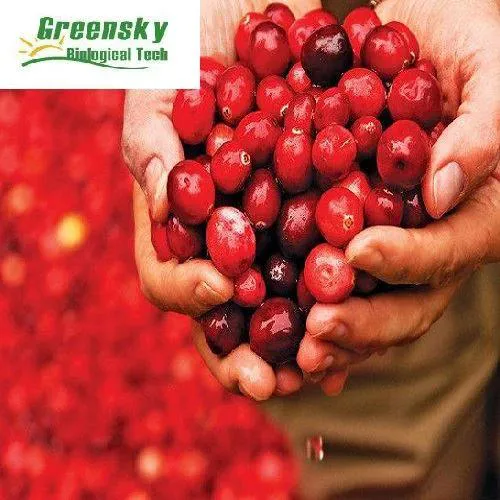- 0086-571-85302990
- sales@greenskybio.com
The process of extracting cranberry proanthocyanidins from cranberry extract.
2024-11-29

1. Introduction
Cranberries are well - known for their rich content of proanthocyanidins. These compounds have a wide range of potential health benefits and are highly valued in various industries, such as food, medicine, and cosmetics. Extracting cranberry proanthocyanidins from Cranberry Extract is a complex yet important process. This article will explore this process in detail.

2. Selection of Cranberry Extract as Raw Material
2.1 Quality Considerations
The first step in the extraction of cranberry proanthocyanidins is to select high - quality Cranberry Extract as the raw material. Quality is of utmost importance as it directly affects the final product. High - quality cranberry extract should come from ripe cranberries that are free from diseases and contaminants. The extraction method used to obtain the initial cranberry extract also plays a role. Extracts obtained through gentle and efficient extraction methods are more likely to yield better results in the subsequent proanthocyanidin extraction.2.2 Source and Variety
Different sources and varieties of cranberries may have varying levels of proanthocyanidin content. Some cranberry varieties are known to be particularly rich in these compounds. Additionally, the geographical origin of the cranberries can also influence their composition. For example, cranberries grown in certain regions may have a more favorable environment for the accumulation of proanthocyanidins. Therefore, when selecting the cranberry extract, these factors need to be taken into account to ensure a high - yield extraction of proanthocyanidins.
3. Solvent Extraction Method
3.1 Choice of Solvents
One of the most commonly used methods for extracting cranberry proanthocyanidins is the solvent extraction method. Appropriate solvents need to be selected for this purpose. Ethanol - water mixtures are often preferred. Ethanol has good solubility properties for proanthocyanidins, and the addition of water can help adjust the polarity of the solvent system. Other solvents or solvent combinations may also be considered depending on specific requirements. For example, some researchers may explore the use of alternative solvents to achieve better selectivity or environmental friendliness.3.2 Optimization of Solvent Ratio
The ratio of the solvent components is crucial for the extraction efficiency. It needs to be carefully optimized. A proper solvent ratio can ensure the highest extraction efficiency while maintaining the integrity of proanthocyanidins. If the ethanol concentration is too high, it may cause some unwanted side reactions or damage to the proanthocyanidin structure. On the other hand, if the water content is too high, the solubility of proanthocyanidins may be reduced. Through experimental studies, researchers can determine the optimal solvent ratio for a particular cranberry extract. For example, a common ratio might be 50:50 or 60:40 (ethanol: water), but this can vary depending on the characteristics of the extract.3.3 Extraction Conditions
In addition to the solvent ratio, other extraction conditions also need to be controlled. These include extraction temperature, extraction time, and agitation speed. The extraction temperature should be set at a level that promotes the dissolution of proanthocyanidins without causing their degradation. Generally, a moderate temperature range, such as between 30 - 60 °C, is often used. The extraction time also affects the yield. Too short an extraction time may result in incomplete extraction, while too long a time may lead to the extraction of unwanted impurities. Agitation speed is important for ensuring good contact between the solvent and the cranberry extract. Appropriate agitation can enhance the mass transfer process and improve the extraction efficiency.
4. Purification Steps
4.1 Need for Purification
After the extraction process, the obtained extract contains not only proanthocyanidins but also other impurities. These impurities can include sugars, proteins, and other phenolic compounds. Purification steps are necessary to obtain pure cranberry proanthocyanidins. Pure proanthocyanidins are required for their use in various applications, especially in the fields of medicine and cosmetics where high purity is crucial for safety and efficacy.4.2 Column Chromatography
One of the effective techniques for purifying cranberry proanthocyanidins is column chromatography. In column chromatography, a column is filled with a stationary phase, such as silica gel or a polymeric resin. The extract is then loaded onto the column, and different components are separated based on their differential interactions with the stationary phase. Proanthocyanidins can be selectively retained or eluted from the column depending on their chemical properties. By adjusting the elution conditions, such as the type and concentration of the eluent, pure proanthocyanidins can be obtained. For example, a gradient elution using different solvents can be employed to separate proanthocyanidins from other impurities effectively.4.3 Other Purification Methods
Besides column chromatography, other purification methods can also be considered. Membrane filtration is one such method. It can be used to separate molecules based on their size. Larger impurities can be removed by using membranes with appropriate pore sizes. Another method is precipitation. By adding certain reagents, some impurities can be precipitated out, leaving the proanthocyanidins in the solution. However, these methods may have their limitations compared to column chromatography in terms of selectivity and efficiency, but they can be used in combination with column chromatography to further improve the purification process.
5. Drying and Concentration Processes
5.1 Drying
After purification, the proanthocyanidin - rich solution needs to be dried to obtain a solid product. Drying is an important step as it helps in the long - term storage and handling of the product. Different drying methods can be used, such as freeze - drying, spray - drying, and vacuum - drying. Freeze - drying is a gentle drying method that can preserve the structure and activity of proanthocyanidins well. However, it is relatively expensive. Spray - drying is a more cost - effective method but may require careful control of the drying conditions to avoid damage to the proanthocyanidins. Vacuum - drying can also be used, which reduces the drying time and helps in maintaining the quality of the product.5.2 Concentration
Concentration of the proanthocyanidin solution may be necessary before drying. This can be achieved through evaporation methods, such as rotary evaporation. By concentrating the solution, the volume is reduced, which is beneficial for the subsequent drying process. It also helps in increasing the concentration of proanthocyanidins in the final product. However, during the concentration process, care should be taken to avoid over - heating, which can lead to the degradation of proanthocyanidins.6. Conclusion
The extraction of cranberry proanthocyanidins from cranberry extract is a multi - step process that involves careful selection of raw materials, optimization of solvent extraction, purification, and drying/concentration steps. Each step is crucial for obtaining high - quality, pure cranberry proanthocyanidins that can be used in a variety of industries. Continued research in this area may lead to further improvements in the extraction process, resulting in more efficient and cost - effective production of cranberry proanthocyanidins.
FAQ:
What are the main solvents used in the extraction of cranberry proanthocyanidins?
Ethanol - water mixtures are often used as solvents in the extraction of cranberry proanthocyanidins. These solvents are chosen because they can effectively extract proanthocyanidins while maintaining their integrity.
Why is column chromatography used in the purification of cranberry proanthocyanidins?
Column chromatography is used in the purification of cranberry proanthocyanidins because it can effectively separate proanthocyanidins from other impurities in the extract. This helps to obtain pure proanthocyanidins for various applications.
How is the ratio of solvent components optimized in the extraction of cranberry proanthocyanidins?
The ratio of solvent components is optimized through experimental research. Different ratios are tested to determine which one can ensure the highest extraction efficiency while maintaining the integrity of proanthocyanidins. This usually involves a series of extraction experiments with different ratios and the evaluation of the results.
What are the applications of cranberry proanthocyanidins in the food industry?
In the food industry, cranberry proanthocyanidins can be used as natural antioxidants, which can help to prevent food spoilage and extend the shelf life of food products. They can also be used to add nutritional value to food, as they are rich in health - promoting components.
What are the benefits of using cranberry extract as the raw material for proanthocyanidin extraction?
Cranberry extract is rich in proanthocyanidins, which makes it an ideal raw material for extraction. Using cranberry extract can ensure a relatively high yield of proanthocyanidins. Moreover, cranberries are known for their health - promoting properties, and the proanthocyanidins extracted from them may inherit these beneficial properties.
Related literature
- Extraction and Characterization of Proanthocyanidins from Cranberries"
- "Optimization of Cranberry Proanthocyanidin Extraction: A Review"
- "The Role of Cranberry Proanthocyanidins in Food and Pharmaceutical Applications"
- ▶ Hesperidin
- ▶ Citrus Bioflavonoids
- ▶ Plant Extract
- ▶ lycopene
- ▶ Diosmin
- ▶ Grape seed extract
- ▶ Sea buckthorn Juice Powder
- ▶ Fruit Juice Powder
- ▶ Hops Extract
- ▶ Artichoke Extract
- ▶ Mushroom extract
- ▶ Astaxanthin
- ▶ Green Tea Extract
- ▶ Curcumin
- ▶ Horse Chestnut Extract
- ▶ Other Product
- ▶ Boswellia Serrata Extract
- ▶ Resveratrol
- ▶ Marigold Extract
- ▶ Grape Leaf Extract
- ▶ New Product
- ▶ Aminolevulinic acid
- ▶ Cranberry Extract
- ▶ Red Yeast Rice
- ▶ Red Wine Extract
-
Alisma Extract
2024-11-29
-
Dan Shen Root Extract/Salvia Root Extract
2024-11-29
-
Oyster Mushroom Extract Powder
2024-11-29
-
Phyllanthus Emblica Extract
2024-11-29
-
Troxerutin
2024-11-29
-
Buckthorn bark extract
2024-11-29
-
Artichoke Leaf Extract
2024-11-29
-
Panax Ginseng Leaf Extract
2024-11-29
-
Longan Extract
2024-11-29
-
Green coffee bean Extract
2024-11-29





















